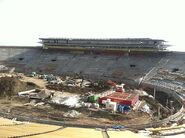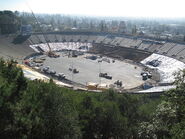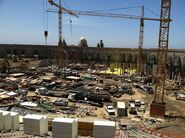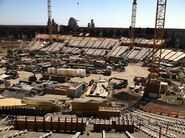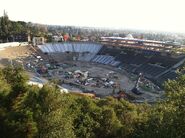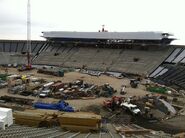| California Memorial Stadium | |
|---|---|
| Memorial Stadium Strawberry Canyon | |
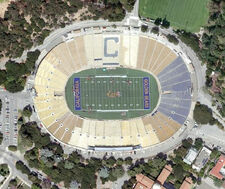 satellite view, November 2008 | |
| Location | 76 Canyon Rd, Berkeley, California 94704 |
| Broke ground | December 1922 (site clearing) July 1, 1923[1] |
| Opened | November 24, 1923 September 1, 2012 (renovation) |
| Owner | University of California, Berkeley |
| Operator | University of California, Berkeley |
| Surface | Matrix Turf (2012–present) Momentum Turf (2003–2010) Grass (1995–2002) AstroTurf (1981–1994) Grass (1923–1980) |
| Construction cost | $1,437,982 $18.6 million (2011) |
| Architect | John Galen Howard[1] Baker & Carpenter[1] George E. Cunningham[1] |
| General Contractor | Clinton Construction Company[1] |
| Tenants | California Golden Bears (NCAA) (1923–2010, 2012–present) |
| Capacity | 63,186 (2012–present)[2] |
California Memorial Stadium is an outdoor football stadium on the campus of the University of California in Berkeley. Commonly known as Memorial Stadium, it is the home field for the University of California Golden Bears of the Pacific-12 Conference. The venue opened in 1923 and currently seats around 63,000 fans for football, making it Northern California's second largest football-only stadium in terms of seating capacity.[3] The playing field runs NW-SE, at an elevation of 410 feet (125 m) above sea level.[4] and was listed in the National Register of Historic Places on November 27, 2006.[5]
Memorial Stadium was funded from public contributions, as a memorial to Californians who lost their lives in World War I (1917–18). The chair of the architectural committee was John Galen Howard, the university's chief architect, and his influence is evident in the stadium's neoclassical motif. In addition to its unique architecture, the stadium's position at the foot of the Berkeley hills provides top row spectators with panoramic views of San Francisco Bay and west side viewers with views of the Berkeley Hills and Strawberry Canyon. This has earned it a reputation as one of the most scenic venues in college football.
Traditionally, during all football games and especially during the Big Game against Stanford, the hill overlooking the eastern side of Memorial Stadium attracts spectators hoping to watch a game for free, earning the nickname "Tightwad Hill".
Before Memorial Stadium[]
West Field[]
On February 14, 1885, the first football game was played on the University of California campus between the hometown Bears and a football club from San Francisco known as the Merions. The field was located where the Valley Life Sciences Building currently stands and the game drew some 450 people. In subsequent years, the field was officially named West Field and was expanded to hold around 5,000 spectators. However, by 1904, California's football team had become so popular that West Field became much much too small, therefore, the university decided to build a new stadium with an excess of 20,000 seats.[6]
California Field[]
California Field opened its doors in 1904 to replace the antiquated West Field and the boosted capacity allowed California to host important games for the first time. While playing at West Field, the Bears played important games (namely the Big Game) at neutral site venues in San Francisco and with a new 20,000 seat stadium, California was able to host the first Big Game played outside of San Francisco. The new stadium was located much closer to the center of campus (where Hearst Gymnasium now stands) and was able to draw unprecedented crowds for the time. California Field is also notable because it is where many of California's longstanding traditions began to take form. In 1910, the first card stunt was performed at the Big Game and after victories, the students would "serpentine" around the field—something that is mentioned in the song "Big C". California Field is also where the Golden Bears gained national prominence under head coach Andrew Latham Smith. Four of the Bears five consecutive undefeated seasons were played at California Field and housed the stadium was home to three of California's four straight (claimed) national championships. Because of this success, it became evident that California needed an even larger venue to host its football team, therefore, the team and its fans began pushing for a new stadium.[6]
The drive to build Memorial Stadium[]
The early 1920s saw four major collegiate venues open in the State of California: Stanford Stadium, the Rose Bowl, the Los Angeles Memorial Coliseum, and California Memorial Stadium. With the success of the California football program and the openings of the new football venues for Stanford and USC, the campus community was nearly unanimous in its desire to see the Bears get a new stadium of their own. One of the first proposals for a new stadium was on the south-western corner of the campus where Edwards Stadium and Evans Diamond currently stand. This proposal was eventually rejected and the regents settled on a site at the mouth of Strawberry Canyon. The location caused considerable controversy, but the popularity of Andy Smith's "Wonder Teams" prevailed and fundraising began in 1922. The 1 million dollar stadium was funded completely by 10,000 seat subscriptions at $100 dollars per subscription, the fundraising drive through these subscriptions was a complete success having sold out in less that ten days. With the funding secured, the university broke ground in January 1923 hoping to open the new stadium in time for the 1923 Big Game.[6]
Original California Memorial Stadium: 1923–2010[]

California Memorial Stadium from the southwest corner in January 2008.
History[]
California played its first seven games of the 1923 season at old California Field preparing to open the new 75,000 seat stadium at Strawberry Canyon for the final game of the season—the Big Game—against Stanford. Both teams were having a good season in 1923 with California going undefeated up to that point (with a tie to Nevada) and Stanford going into the Big Game with a record of 7–1. Leading up to the first game at Memorial Stadium, some in the media suggested to Bears coach Andy Smith that the opening of new stadiums was cursed: Stanford lost the first game played at Stanford Stadium while USC lost the inaugural game of both the Rose Bowl and the Los Angeles Coliseum. Smith simply replied, "Why, of course they did, it was always California they invited to help dedicate their stadiums." The Bears went on to win the inaugural game at California Memorial Stadium by a final score of 9–0, beating Stanford for the fifth straight year and securing their fourth straight undefeated season.[6]
When California Memorial Stadium opened in 1923, the permanent capacity of the venue was around 75,000 and expandable to around 85,000. For important games, the university would bring out temporary bleachers that would stand around the eastern rim of the stadium. It was during this time, that California set their all-time attendance record in 1947 with an announced crowd of 83,000 for a game against Navy. As the California football team's fortunes on the field began to fall in the second half of the century and there was a demand for wheelchair seating along the eastern rim, the university did away with the temporary bleachers bringing the stadium's maximum football capacity back down to the permanent capacity of 75,000. Due to the seismic vulnerability of the old press box, the University of California dismantled the structure and installed a temporary facility that stood until the 2010 season. The installation of the temporary press box brought the stadium's capacity down to 73,347 and then down to 72,516 for the 2004 season. California brought the seating capacity further down to 67,537 with tarps being placed over four sections (one in each corner). The university did remove the tarps, however, for important games allowing a full 72,516 to attend. Because of safety concerns, the university brought the capacity down to 71,799 for the 2008 season.
After the 2010 season, the entire west side of the bowl was demolished and rebuilt. The stands in the original stadium descended right down to the football field, and the view from the lowest midfield seats on the west side could be blocked by the standing visiting team members. To eliminate this problem, the surface of the field was lowered four feet to allow unobstructed seats in the first few rows during the 2010-12 renovation.[7] The capacity of the refurbished stadium is now 63,186, and was sold out for the first game of the 2012 season in a 31-24 Cal loss against the Nevada Wolf Pack.
Capacity[]
- 2012–present: 63,186
- 2008–2010: 71,799
- 2006–2007: 72,516
- 2003–2005: 67,537 (expandable to 72,516)
- 2002: 73,347
- 1998–2001: 75,028
- 1996–1997: 74,909
- 1982–1995: 75,662
- 1961–1981: 76,780
- 1951–1960: 81,490
- 1949–1950: 80,239
- 1938–1948: 80,000
- 1937: 77,963
- 1927–1936: 78,461
- 1926: 78,671
- 1923–1925: 72,609
Other major events[]
California Memorial Stadium has seen a number of major events throughout the years other than California football. Before 1970, the general commencement exercises of the University of California was regularly held at Memorial Stadium. The large campus-wide commencement, however, was cancelled in 1970 because of the many protests that were taking place at the time—university officials at the time did not see it wise to have such a large gathering annually with the protests going on.[8] General Commencements have since returned to the University of California campus, with the exercises being performed at Haas Pavilion, Hearst Greek Theatre, and most recently Edwards Stadium.[9] On March 23, 1962, to commemorate Charter Day (the anniversary of the founding of the University of California), President John F. Kennedy gave a speech at Memorial Stadium in front of an above capacity crowd of 88,000.[10][11]
Oakland Raiders[]
The NFL's Oakland Raiders played their second game of the 1973 regular season at Memorial Stadium. The game against the defending Super Bowl champion Miami Dolphins was moved from the Raiders' regular home, the Oakland Coliseum, because of a scheduling conflict with baseball's Oakland Athletics, who hosted the Minnesota Twins at the Coliseum the following night. The Raiders ended the Dolphins' NFL record 18-game winning streak with a 12-7 victory on four field goals by 45-year-old George Blanda on September 23.[12] Several preseason games were also played at the stadium in the early 1970s.
Ultimately, in response to traffic and parking issues associated with these games (while Cal games drew a large number of students who live on or near campus and walk to the games, Raider games attracted fans from a larger geographic area who were used to tailgating at the Coliseum and were more likely to drive to games), the City of Berkeley passed a Professional Sports Events License Tax in which the city collected 10% of all gate receipts, making the staging of professional games inside the city cost-prohibitive. The Raiders were granted an injunction from the city collecting the tax, arguing that the tax was a regulatory measure rather than a revenue measure, and was therefore an improper regulation on land held in trust by the Regents of the University of California. However, the grant of the injunction was reversed by the California Court of Appeals, who found it to be a revenue measure, despite the fact that the city had made the measure immediately effective "due to danger to the public peace, health, and safety of the City of Berkeley as a result of the holding of professional sports events there."[13]
Playing surface[]
Originally a natural grass field, AstroTurf was installed in Memorial Stadium in 1981 and remained for 14 seasons. Natural grass returned for the 1995 season, until the 2003 installation of Momentum Turf, an infilled artificial turf, similar to FieldTurf.[14] The Momentum Turf surface allowed for minimal maintenance and increased utilization of the stadium, for football practices and other sports, on the space-limited UC Berkeley campus. After returning to natural turf in 1995, varsity football practices were held at Witter Rugby Field, saving the stadium's grass field for game days only. Memorial Stadium's field is also marked for international soccer, but this allows little reserve room beyond the official lines.
California Memorial Stadium Renovation: 2010–2012[]
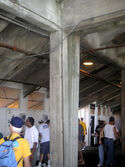
Memorial Stadium supporting columns diverging due to fault creep
Need for Renovation[]
The Hayward Fault passes directly under the playing field of Memorial Stadium (nearly from goal post to goal post),[15] where right-lateral strike-slip motion is shifting the northeast half of the building to the southwest at a rate of 1.2 mm/yr. Expansion joints have been placed in the walls of the stadium to maintain the integrity of the building. A 1998 seismic safety study on the California campus gave the stadium a "poor" rating (meaning that the building represents an "appreciable life hazard" in an earthquake), and estimated the cost of making the structure safe at $14 million.[16] Because the stadium is on the U.S. National Register of Historic Places and because of the nostalgia that surrounds the site, the university decided that a retrofit and renovation (as opposed to building a new stadium elsewhere) would be the best scenario for the California football program. In February 2005, Chancellor Robert Birgeneau announced plans to renovate Memorial Stadium, improving the existing facilities and creating a safer environment for the fans as well as the people that work at the stadium.
Phase I[]
Phase I consisted of building the 142,000-square-foot (13,200 m2) Student-Athlete High Performance Center next to the west wall of the stadium. The center was built to be the home of football and 12 of California's Olympic sports that were previously housed in Memorial Stadium. The center saw the construction of new locker rooms, offices meeting rooms, training and sports medicine facilities, and an academic center in the SAHPC.[17] The roof of the athletic center also acts as a pedestrian plaza. Phase I of the renovations were originally scheduled to begin the spring and summer of 2006 but was delayed by a court injunction due to three lawsuits against the project. A small group of tree-sitters occupied the oak grove on the west side of the stadium beginning on the "Big Game" day in December 2006 but in September 2008 the court injunction was lifted, the protesters came down, and construction of the athletic center began. The Simpson Center for Student-Athlete High Performance (originally SAHPC) opened in the Fall of 2011 and became 100% operational in January 2012.
Phase II[]
On January 19, 2010 the UC Board of Regents approved the retrofit and renovation of California Memorial Stadium. The $321 million project commenced in June 2010 and was completed in time for the 2012 season. The Bears played at AT&T Park in San Francisco for the 2011 season while the renovations were being made.[18] The west side of the stadium was demolished and rebuilt except for the outer wall. Club levels, a new press box, bathrooms and concession stands were added. The surface of the field was lowered four feet to improve the view from the lowest midfield seats on the west side, which previously were blocked by standing visiting team members. A surface rupture block was placed in each end zone where the fault line passes through the stadium. These blocks can move independently from the rest of the stadium and were built on top of three feet of sand and plastic sheets. Expansion joints were placed between the surface rupture blocks and the rest of the stadium.[19]
Phase III[]
Phase III of the Memorial Stadium renovation and retrofit is the renovation of the stadium's east side by adding modern amenities to that side of the stadium. Originally, this part of the project was to begin in the Fall of 2009, but because of the delay of phase II, the east side's improvements have been delayed indefinitely. The eventual improvements on the east side of the stadium called for an extension of the concourse to wrap around the stadium, new restrooms, ADA seating, and vendors.[20][21]
Renovated California Memorial Stadium: 2012–present[]
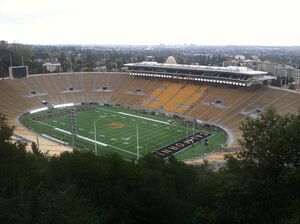
California Memorial Stadium during the 2012 football season.
2012 Season[]
The University of California reopened the stadium on September 1, 2012 for a home football game against the University of Nevada. This was the first football game in Berkeley since the end of the 2010 season. The sellout crowd of 63,186 watched the Nevada Wolf Pack spoil the grand re-opening with a 31-24 victory, Cal's first loss to Nevada at home since before the original stadium opened in 1923. There are many noticeable differences between the new, more modern stadium and the old stadium that closed in 2010. The entire west side of the stadium was demolished (except for the historic façade), allowing the university to make the venue seismically safe, and add modern amenities. The east side, however, has remained relatively unchanged. The stadium was originally dedicated to the memory of those Californians that were lost in World War I, and on October 6, 2012 the university rededicated California Memorial Stadium in the memory of all Californians who sacrificed their lives in service to the nation.[22]
Capacity[]
Because of the inclusion of seat back and bench back seating in the same footprint as before, the renovation and retrofit reduced the seating capacity by around 10,000 seats. Original estimates stated that the official stadium capacity would be around 63,000–65,000, down from the 71,799 capacity that Memorial Stadium had in 2010. Capacity at the beginning of the 2012 season ended up at 63,186.
2012–present: 63,186[2]
Estimate during construction: 62,717[23]
Playing surface[]
The playing field was lowered 4 ft (1.2 m) to improve sight lines,[2] and surfaced with Matrix Turf, an artificial turf with crumb rubber infill along with a silica pea gravel base to allow improved field drainage.[24]
Construction gallery[]
References[]
- ↑ 1.0 1.1 1.2 1.3 1.4 California Memorial Staidum (Berkeley, California) Historic Landscape Report. University of California (March 2006). Retrieved on August 22, 2012.
- ↑ 2.0 2.1 2.2 Memorial Stadium Facts at a Glance - The University of California Official Athletic Site. Calbears.com. Retrieved on 2012-10-03.
- ↑ Memorial Stadium. University of California, Berkeley. Retrieved on March 17, 2007.
- ↑ MSRMaps. MSRMaps (1996-01-07). Retrieved on 2012-10-03.
- ↑ Cite error: Invalid
<ref>tag; no text was provided for refs namednris - ↑ 6.0 6.1 6.2 6.3 The House that Andy Built: The Making of Memorial Stadium. California Golden Blogs (December 15, 2010). Retrieved on August 22, 2012.
- ↑ Memorial Stadium. University of California. Retrieved on August 22, 2012.
- ↑ Huseby, Janet. "Berkeley commencement: It's not a day, it's a season", Office of the Chancellor at the University of California, Spring 2002. Retrieved on August 22, 2012.
- ↑ Yurovsky, Oksana. "Thousands of Students Set to Graduate at Increasingly Popular Commencement", May 10, 2012. Retrieved on August 22, 2012.
- ↑ Charter Day 1962: JFK on Soviet-American Cooperation, Space Science, State Support for Higher Education. University of California Public Affairs (March 23, 2012). Retrieved on August 22, 2012.
- ↑ Address at the University of California at Berkeley, March 23, 1962. John F. Kennedy Presidential Library and Museum. Retrieved on August 22, 2012.
- ↑ Troan, John. 1973 Oakland Raiders. jt-sw.com. Retrieved on August 22, 2012.
- ↑ Oakland Raiders vs. City of Berkeley, 65 Cal. App. 3d 623. law.justia.com.
- ↑ Memorial Stadium. University of California. Retrieved on August 22, 2012.
- ↑ The Hayward Fault at UC Berkeley. University of California Berkeley Seismological Laboratory. Archived from the original on July 16, 2012. Retrieved on August 22, 2012.
- ↑ 10.24.97 - SAFER Program - Findings and Implications. Berkeley.edu (1998-04-24). Retrieved on 2012-10-03.
- ↑ Student-Athlete High Performance Center Project Description. UC Berkeley. Retrieved on July 6, 2009.
- ↑ Template:Cite press release
- ↑ "Engineering a $321 Million Quake Retrofit for UC Stadium", Wired Magazine, December 27, 2010. Retrieved on February 1, 2011.
- ↑ Whiting, Sam. "Cal's Crumbling Home / Stadium on the Brink / Eccentricities still there to charm and confound", June 27, 2011.
- ↑ Blue, Old (2010-03-23). Golden Facilities: Deep into the Future, East Side Renovations. California Golden Blogs. Retrieved on 2012-10-03.
- ↑ Template:Cite press release
- ↑ Cal Memorial Stadium. Webcor. Retrieved on 2012-10-03.
- ↑ Template:Cite press release
External links[]
- The Campaign for Student Athletes - California Memorial Stadium
- Berkeley Architectural Heritage Association (BAHA) - Memorial Stadium information
- California Engineer - see Fall 2005 issue
- Calbears.com - official athletics site - Memorial Stadium
- Seismo.Berkeley.edu - Hayward Fault - UC-Berkeley campus
- World Stadiums.com - photos - Memorial Stadium
- msrmaps.com - satellite color photo (2004) (& USGS topo map) - UC-Berkeley campus
| This page uses Creative Commons Licensed content from Wikipedia (view authors). |

